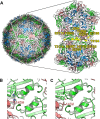SAT2 Foot-and-Mouth Disease Virus Structurally Modified for Increased Thermostability
- PMID: 28298597
- PMCID: PMC5411616
- DOI: 10.1128/JVI.02312-16
SAT2 Foot-and-Mouth Disease Virus Structurally Modified for Increased Thermostability
Abstract
Foot-and-mouth disease virus (FMDV), particularly strains of the O and SAT serotypes, is notoriously unstable. Consequently, vaccines derived from heat-labile SAT viruses have been linked to the induction of immunity with a poor duration and hence require more frequent vaccinations to ensure protection. In silico calculations predicted residue substitutions that would increase interactions at the interpentamer interface, supporting increased stability. We assessed the stability of the 18 recombinant mutant viruses in regard to their growth kinetics, antigenicity, plaque morphology, genetic stability, and temperature, ionic, and pH stability by using Thermofluor and inactivation assays in order to evaluate potential SAT2 vaccine candidates with improved stability. The most stable mutant for temperature and pH stability was the S2093Y single mutant, while other promising mutants were the E3198A, L2094V, and S2093H single mutants and the F2062Y-H2087M-H3143V triple mutant. Although the S2093Y mutant had the greatest stability, it exhibited smaller plaques, a reduced growth rate, a change in monoclonal antibody footprint, and poor genetic stability properties compared to those of the wild-type virus. However, these factors affecting production can be overcome. The addition of 1 M NaCl was found to further increase the stability of the SAT2 panel of viruses. The S2093Y and S2093H mutants were selected for future use in stabilizing SAT2 vaccines.IMPORTANCE Foot-and-mouth disease virus (FMDV) causes a highly contagious acute vesicular disease in cloven-hoofed livestock and wildlife. The control of the disease by vaccination is essential, especially at livestock-wildlife interfaces. The instability of some serotypes, such as SAT2, affects the quality of vaccines and therefore the duration of immunity. We have shown that we can improve the stability of SAT2 viruses by mutating residues at the capsid interface through predictive modeling. This is an important finding for the potential use of such mutants in improving the stability of SAT2 vaccines in countries where FMD is endemic, which rely heavily on the maintenance of the cold chain, with potential improvement to the duration of immune responses.
Keywords: FMDV; SAT2; stability.
Copyright © 2017 American Society for Microbiology.
Figures






Similar articles
-
Inherent biophysical stability of foot-and-mouth disease SAT1, SAT2 and SAT3 viruses.Virus Res. 2019 Apr 15;264:45-55. doi: 10.1016/j.virusres.2019.02.012. Epub 2019 Feb 23. Virus Res. 2019. PMID: 30807778
-
A Heat-Induced Mutation on VP1 of Foot-and-Mouth Disease Virus Serotype O Enhanced Capsid Stability and Immunogenicity.J Virol. 2021 Jul 26;95(16):e0017721. doi: 10.1128/JVI.00177-21. Epub 2021 Jul 26. J Virol. 2021. PMID: 34011545 Free PMC article.
-
Chimeric O1K foot-and-mouth disease virus with SAT2 outer capsid as an FMD vaccine candidate.Sci Rep. 2018 Sep 12;8(1):13654. doi: 10.1038/s41598-018-31856-x. Sci Rep. 2018. PMID: 30209254 Free PMC article.
-
Targeted FMD Vaccines for Eastern Africa: The AgResults Foot and Mouth Disease Vaccine Challenge Project.Viruses. 2021 Sep 14;13(9):1830. doi: 10.3390/v13091830. Viruses. 2021. PMID: 34578411 Free PMC article. Review.
-
Development of vaccines toward the global control and eradication of foot-and-mouth disease.Expert Rev Vaccines. 2011 Mar;10(3):377-87. doi: 10.1586/erv.11.4. Expert Rev Vaccines. 2011. PMID: 21434805 Review.
Cited by
-
Features that matter: Evolutionary signatures can predict viral transmission routes.PLoS Pathog. 2024 Oct 21;20(10):e1012629. doi: 10.1371/journal.ppat.1012629. eCollection 2024 Oct. PLoS Pathog. 2024. PMID: 39432551 Free PMC article.
-
Optimized Adenoviral Vector That Enhances the Assembly of FMDV O1 Virus-Like Particles in situ Increases Its Potential as Vaccine for Serotype O Viruses.Front Microbiol. 2020 Nov 4;11:591019. doi: 10.3389/fmicb.2020.591019. eCollection 2020. Front Microbiol. 2020. PMID: 33250878 Free PMC article.
-
Development of a Potent Stabilizer for Long-Term Storage of Foot-and-Mouth Disease Vaccine Antigens.Vaccines (Basel). 2021 Mar 12;9(3):252. doi: 10.3390/vaccines9030252. Vaccines (Basel). 2021. PMID: 33809252 Free PMC article.
-
Calcium Chloride as a Novel Stabilizer for Foot-and-Mouth Disease Virus and Its Application in the Vaccine Formulation.Vaccines (Basel). 2024 Mar 29;12(4):367. doi: 10.3390/vaccines12040367. Vaccines (Basel). 2024. PMID: 38675749 Free PMC article.
-
The rescue and selection of thermally stable type O vaccine candidate strains of foot-and-mouth disease virus.Arch Virol. 2021 Aug;166(8):2131-2140. doi: 10.1007/s00705-021-05100-3. Epub 2021 May 18. Arch Virol. 2021. PMID: 34003358
References
-
- Domingo E, Diez J, Martinez MA, Hernandez JH, Holguin A, Borrego B, Mateu MG. 1993. New observations on antigenic diversification of RNA viruses. Antigenic variation is not dependent on immune selection. J Gen Virol 74:2039–2045. - PubMed
-
- Scoones I, Bishi A, Mapitse N, Moerane R, Penrith ML, Sibanda R, Thomson G, Wolmer W. 2010. Foot-and-mouth disease and market access: challenges for the beef industry in southern Africa. Development 1:135–164.
Publication types
MeSH terms
Substances
Grants and funding
LinkOut - more resources
Full Text Sources
Other Literature Sources
Research Materials

